Features of Effective Performance - PDF
VerifiedAdded on 2021/02/19
|16
|4160
|40
AI Summary
Contribute Materials
Your contribution can guide someone’s learning journey. Share your
documents today.

Unit 510
Secure Best Marks with AI Grader
Need help grading? Try our AI Grader for instant feedback on your assignments.
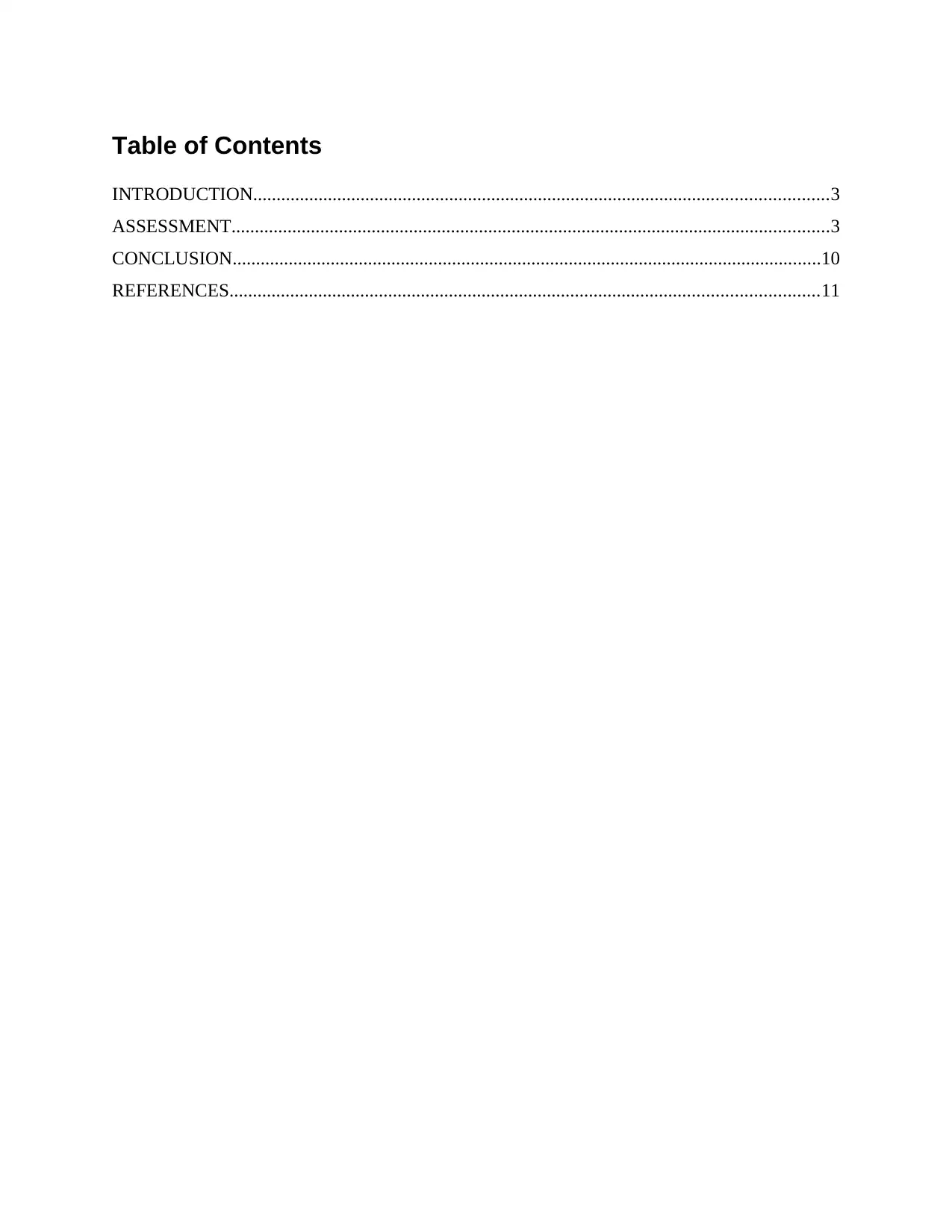
Table of Contents
INTRODUCTION...........................................................................................................................3
ASSESSMENT................................................................................................................................3
CONCLUSION..............................................................................................................................10
REFERENCES..............................................................................................................................11
INTRODUCTION...........................................................................................................................3
ASSESSMENT................................................................................................................................3
CONCLUSION..............................................................................................................................10
REFERENCES..............................................................................................................................11
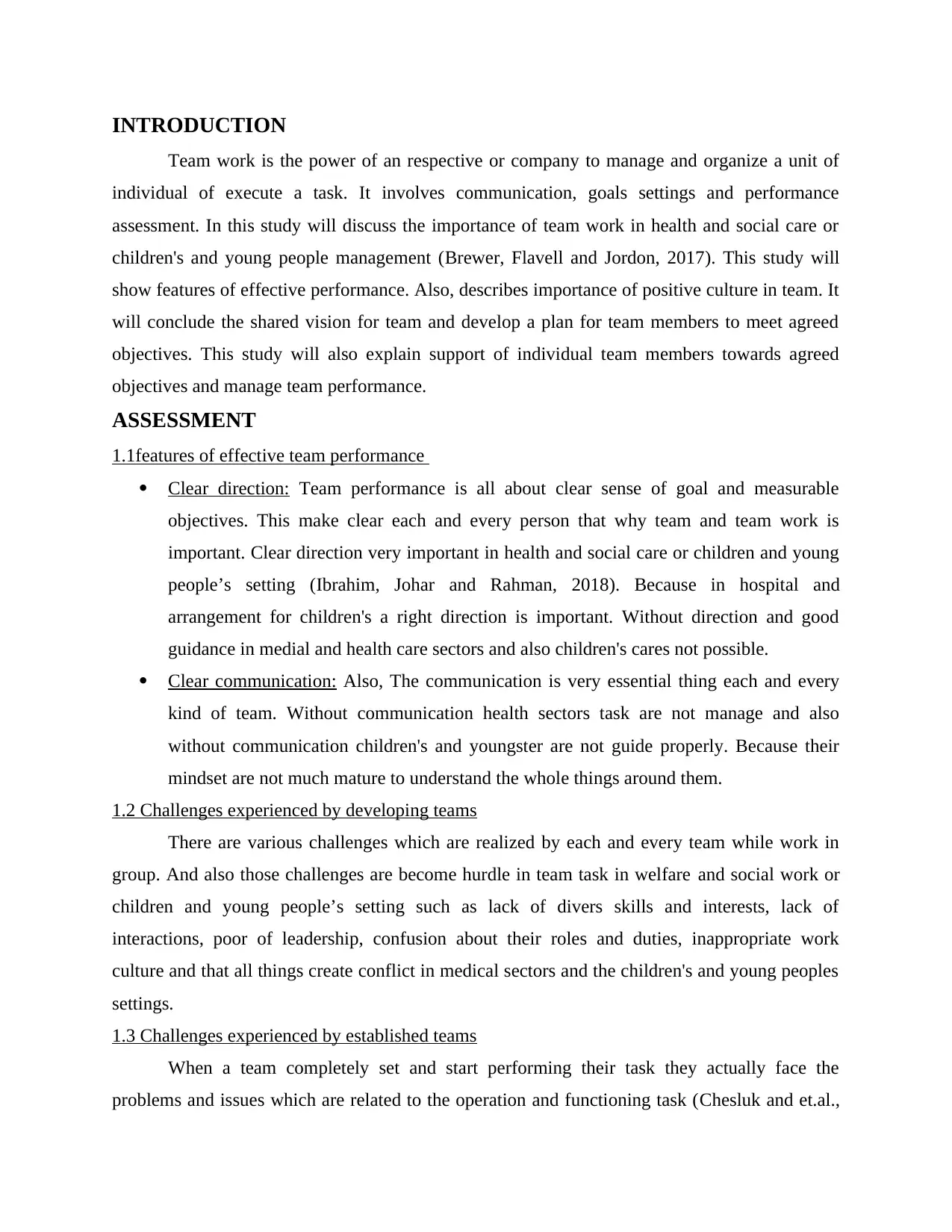
INTRODUCTION
Team work is the power of an respective or company to manage and organize a unit of
individual of execute a task. It involves communication, goals settings and performance
assessment. In this study will discuss the importance of team work in health and social care or
children's and young people management (Brewer, Flavell and Jordon, 2017). This study will
show features of effective performance. Also, describes importance of positive culture in team. It
will conclude the shared vision for team and develop a plan for team members to meet agreed
objectives. This study will also explain support of individual team members towards agreed
objectives and manage team performance.
ASSESSMENT
1.1features of effective team performance
Clear direction: Team performance is all about clear sense of goal and measurable
objectives. This make clear each and every person that why team and team work is
important. Clear direction very important in health and social care or children and young
people’s setting (Ibrahim, Johar and Rahman, 2018). Because in hospital and
arrangement for children's a right direction is important. Without direction and good
guidance in medial and health care sectors and also children's cares not possible.
Clear communication: Also, The communication is very essential thing each and every
kind of team. Without communication health sectors task are not manage and also
without communication children's and youngster are not guide properly. Because their
mindset are not much mature to understand the whole things around them.
1.2 Challenges experienced by developing teams
There are various challenges which are realized by each and every team while work in
group. And also those challenges are become hurdle in team task in welfare and social work or
children and young people’s setting such as lack of divers skills and interests, lack of
interactions, poor of leadership, confusion about their roles and duties, inappropriate work
culture and that all things create conflict in medical sectors and the children's and young peoples
settings.
1.3 Challenges experienced by established teams
When a team completely set and start performing their task they actually face the
problems and issues which are related to the operation and functioning task (Chesluk and et.al.,
Team work is the power of an respective or company to manage and organize a unit of
individual of execute a task. It involves communication, goals settings and performance
assessment. In this study will discuss the importance of team work in health and social care or
children's and young people management (Brewer, Flavell and Jordon, 2017). This study will
show features of effective performance. Also, describes importance of positive culture in team. It
will conclude the shared vision for team and develop a plan for team members to meet agreed
objectives. This study will also explain support of individual team members towards agreed
objectives and manage team performance.
ASSESSMENT
1.1features of effective team performance
Clear direction: Team performance is all about clear sense of goal and measurable
objectives. This make clear each and every person that why team and team work is
important. Clear direction very important in health and social care or children and young
people’s setting (Ibrahim, Johar and Rahman, 2018). Because in hospital and
arrangement for children's a right direction is important. Without direction and good
guidance in medial and health care sectors and also children's cares not possible.
Clear communication: Also, The communication is very essential thing each and every
kind of team. Without communication health sectors task are not manage and also
without communication children's and youngster are not guide properly. Because their
mindset are not much mature to understand the whole things around them.
1.2 Challenges experienced by developing teams
There are various challenges which are realized by each and every team while work in
group. And also those challenges are become hurdle in team task in welfare and social work or
children and young people’s setting such as lack of divers skills and interests, lack of
interactions, poor of leadership, confusion about their roles and duties, inappropriate work
culture and that all things create conflict in medical sectors and the children's and young peoples
settings.
1.3 Challenges experienced by established teams
When a team completely set and start performing their task they actually face the
problems and issues which are related to the operation and functioning task (Chesluk and et.al.,
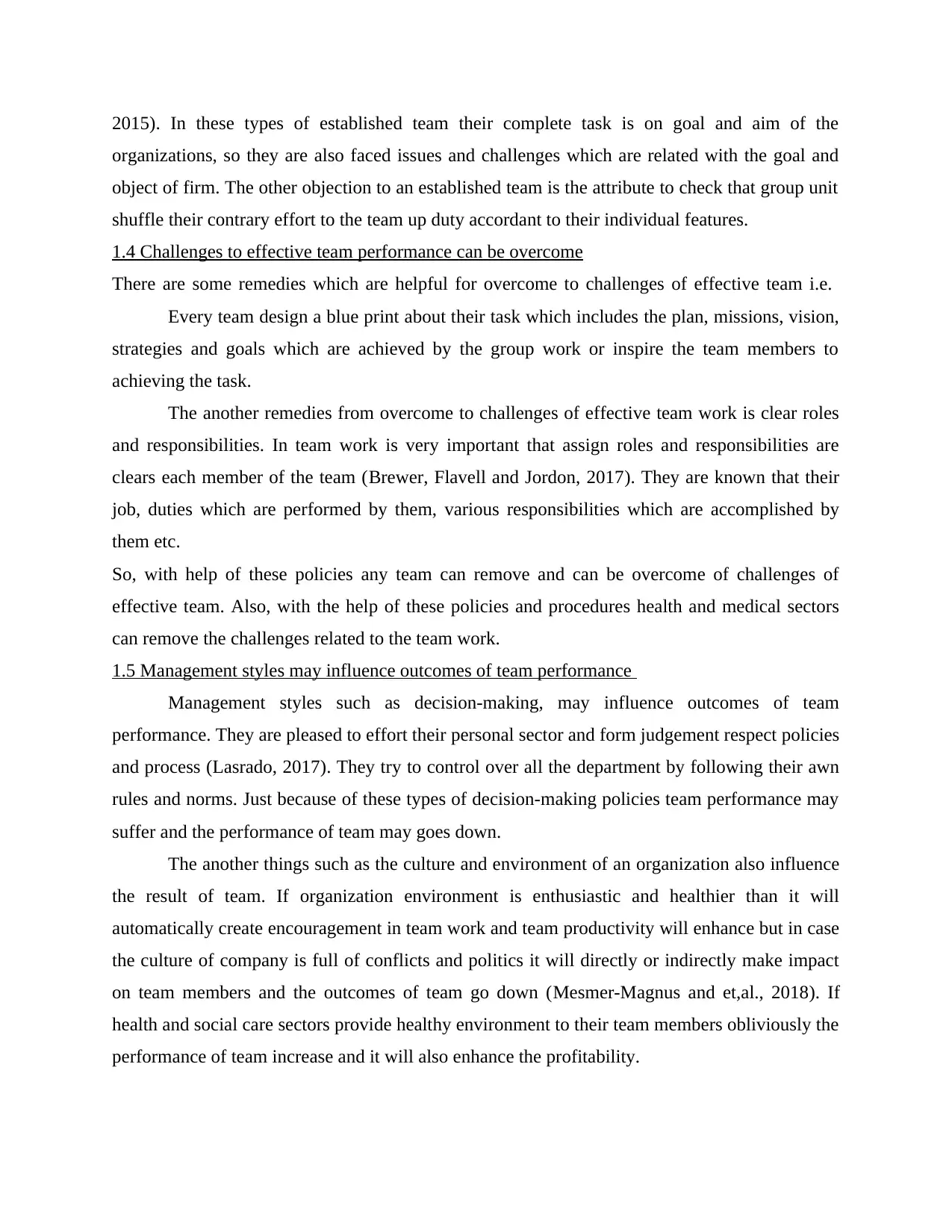
2015). In these types of established team their complete task is on goal and aim of the
organizations, so they are also faced issues and challenges which are related with the goal and
object of firm. The other objection to an established team is the attribute to check that group unit
shuffle their contrary effort to the team up duty accordant to their individual features.
1.4 Challenges to effective team performance can be overcome
There are some remedies which are helpful for overcome to challenges of effective team i.e.
Every team design a blue print about their task which includes the plan, missions, vision,
strategies and goals which are achieved by the group work or inspire the team members to
achieving the task.
The another remedies from overcome to challenges of effective team work is clear roles
and responsibilities. In team work is very important that assign roles and responsibilities are
clears each member of the team (Brewer, Flavell and Jordon, 2017). They are known that their
job, duties which are performed by them, various responsibilities which are accomplished by
them etc.
So, with help of these policies any team can remove and can be overcome of challenges of
effective team. Also, with the help of these policies and procedures health and medical sectors
can remove the challenges related to the team work.
1.5 Management styles may influence outcomes of team performance
Management styles such as decision-making, may influence outcomes of team
performance. They are pleased to effort their personal sector and form judgement respect policies
and process (Lasrado, 2017). They try to control over all the department by following their awn
rules and norms. Just because of these types of decision-making policies team performance may
suffer and the performance of team may goes down.
The another things such as the culture and environment of an organization also influence
the result of team. If organization environment is enthusiastic and healthier than it will
automatically create encouragement in team work and team productivity will enhance but in case
the culture of company is full of conflicts and politics it will directly or indirectly make impact
on team members and the outcomes of team go down (Mesmer-Magnus and et,al., 2018). If
health and social care sectors provide healthy environment to their team members obliviously the
performance of team increase and it will also enhance the profitability.
organizations, so they are also faced issues and challenges which are related with the goal and
object of firm. The other objection to an established team is the attribute to check that group unit
shuffle their contrary effort to the team up duty accordant to their individual features.
1.4 Challenges to effective team performance can be overcome
There are some remedies which are helpful for overcome to challenges of effective team i.e.
Every team design a blue print about their task which includes the plan, missions, vision,
strategies and goals which are achieved by the group work or inspire the team members to
achieving the task.
The another remedies from overcome to challenges of effective team work is clear roles
and responsibilities. In team work is very important that assign roles and responsibilities are
clears each member of the team (Brewer, Flavell and Jordon, 2017). They are known that their
job, duties which are performed by them, various responsibilities which are accomplished by
them etc.
So, with help of these policies any team can remove and can be overcome of challenges of
effective team. Also, with the help of these policies and procedures health and medical sectors
can remove the challenges related to the team work.
1.5 Management styles may influence outcomes of team performance
Management styles such as decision-making, may influence outcomes of team
performance. They are pleased to effort their personal sector and form judgement respect policies
and process (Lasrado, 2017). They try to control over all the department by following their awn
rules and norms. Just because of these types of decision-making policies team performance may
suffer and the performance of team may goes down.
The another things such as the culture and environment of an organization also influence
the result of team. If organization environment is enthusiastic and healthier than it will
automatically create encouragement in team work and team productivity will enhance but in case
the culture of company is full of conflicts and politics it will directly or indirectly make impact
on team members and the outcomes of team go down (Mesmer-Magnus and et,al., 2018). If
health and social care sectors provide healthy environment to their team members obliviously the
performance of team increase and it will also enhance the profitability.
Secure Best Marks with AI Grader
Need help grading? Try our AI Grader for instant feedback on your assignments.
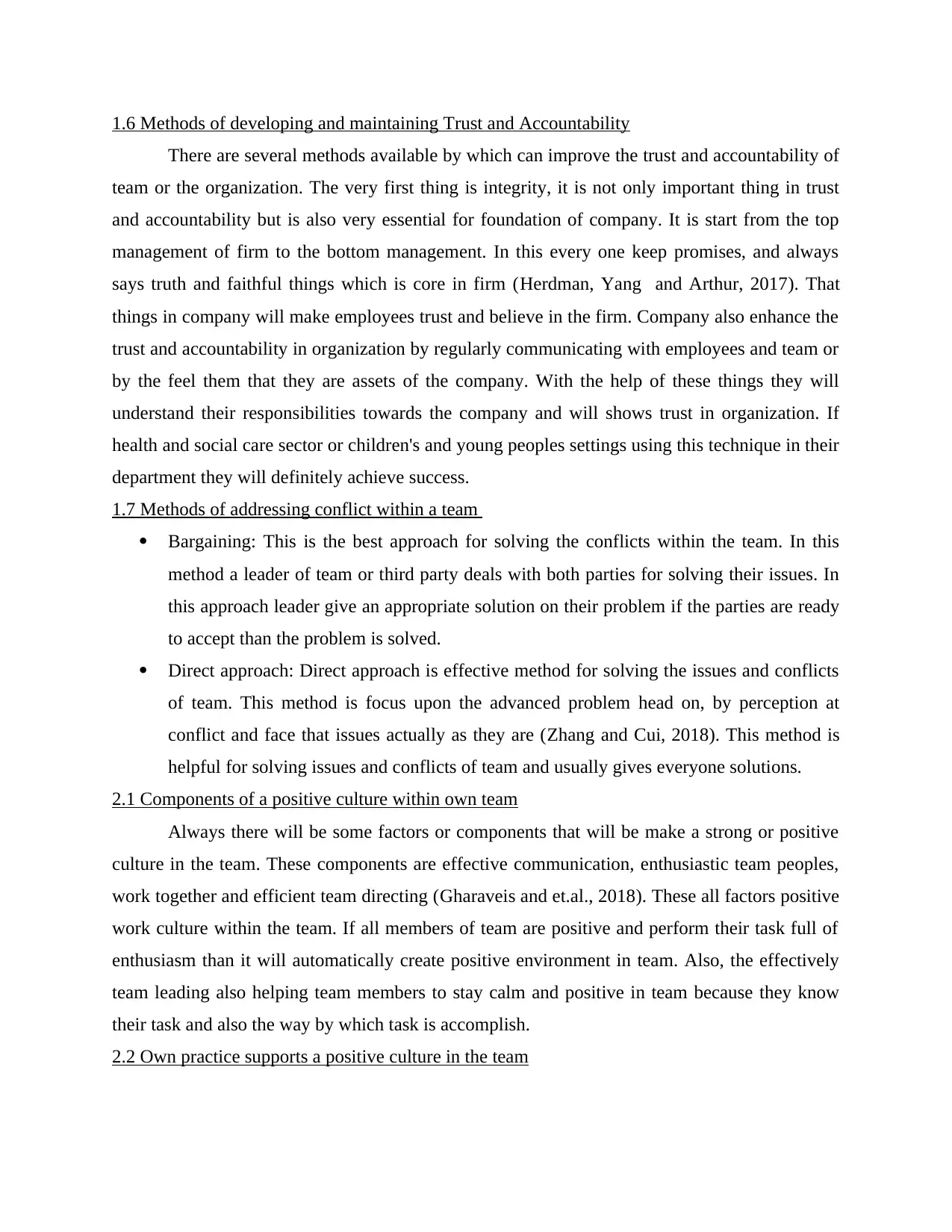
1.6 Methods of developing and maintaining Trust and Accountability
There are several methods available by which can improve the trust and accountability of
team or the organization. The very first thing is integrity, it is not only important thing in trust
and accountability but is also very essential for foundation of company. It is start from the top
management of firm to the bottom management. In this every one keep promises, and always
says truth and faithful things which is core in firm (Herdman, Yang and Arthur, 2017). That
things in company will make employees trust and believe in the firm. Company also enhance the
trust and accountability in organization by regularly communicating with employees and team or
by the feel them that they are assets of the company. With the help of these things they will
understand their responsibilities towards the company and will shows trust in organization. If
health and social care sector or children's and young peoples settings using this technique in their
department they will definitely achieve success.
1.7 Methods of addressing conflict within a team
Bargaining: This is the best approach for solving the conflicts within the team. In this
method a leader of team or third party deals with both parties for solving their issues. In
this approach leader give an appropriate solution on their problem if the parties are ready
to accept than the problem is solved.
Direct approach: Direct approach is effective method for solving the issues and conflicts
of team. This method is focus upon the advanced problem head on, by perception at
conflict and face that issues actually as they are (Zhang and Cui, 2018). This method is
helpful for solving issues and conflicts of team and usually gives everyone solutions.
2.1 Components of a positive culture within own team
Always there will be some factors or components that will be make a strong or positive
culture in the team. These components are effective communication, enthusiastic team peoples,
work together and efficient team directing (Gharaveis and et.al., 2018). These all factors positive
work culture within the team. If all members of team are positive and perform their task full of
enthusiasm than it will automatically create positive environment in team. Also, the effectively
team leading also helping team members to stay calm and positive in team because they know
their task and also the way by which task is accomplish.
2.2 Own practice supports a positive culture in the team
There are several methods available by which can improve the trust and accountability of
team or the organization. The very first thing is integrity, it is not only important thing in trust
and accountability but is also very essential for foundation of company. It is start from the top
management of firm to the bottom management. In this every one keep promises, and always
says truth and faithful things which is core in firm (Herdman, Yang and Arthur, 2017). That
things in company will make employees trust and believe in the firm. Company also enhance the
trust and accountability in organization by regularly communicating with employees and team or
by the feel them that they are assets of the company. With the help of these things they will
understand their responsibilities towards the company and will shows trust in organization. If
health and social care sector or children's and young peoples settings using this technique in their
department they will definitely achieve success.
1.7 Methods of addressing conflict within a team
Bargaining: This is the best approach for solving the conflicts within the team. In this
method a leader of team or third party deals with both parties for solving their issues. In
this approach leader give an appropriate solution on their problem if the parties are ready
to accept than the problem is solved.
Direct approach: Direct approach is effective method for solving the issues and conflicts
of team. This method is focus upon the advanced problem head on, by perception at
conflict and face that issues actually as they are (Zhang and Cui, 2018). This method is
helpful for solving issues and conflicts of team and usually gives everyone solutions.
2.1 Components of a positive culture within own team
Always there will be some factors or components that will be make a strong or positive
culture in the team. These components are effective communication, enthusiastic team peoples,
work together and efficient team directing (Gharaveis and et.al., 2018). These all factors positive
work culture within the team. If all members of team are positive and perform their task full of
enthusiasm than it will automatically create positive environment in team. Also, the effectively
team leading also helping team members to stay calm and positive in team because they know
their task and also the way by which task is accomplish.
2.2 Own practice supports a positive culture in the team
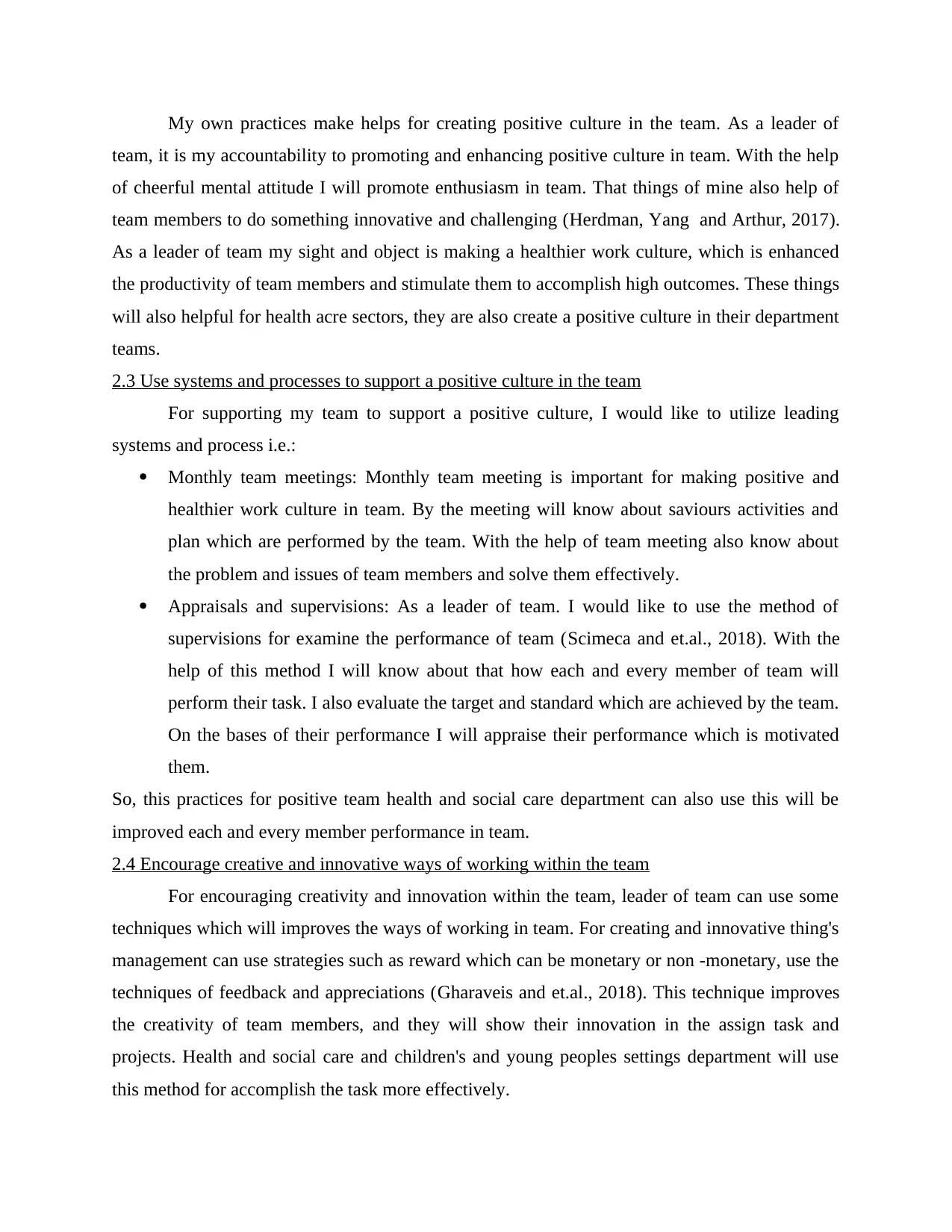
My own practices make helps for creating positive culture in the team. As a leader of
team, it is my accountability to promoting and enhancing positive culture in team. With the help
of cheerful mental attitude I will promote enthusiasm in team. That things of mine also help of
team members to do something innovative and challenging (Herdman, Yang and Arthur, 2017).
As a leader of team my sight and object is making a healthier work culture, which is enhanced
the productivity of team members and stimulate them to accomplish high outcomes. These things
will also helpful for health acre sectors, they are also create a positive culture in their department
teams.
2.3 Use systems and processes to support a positive culture in the team
For supporting my team to support a positive culture, I would like to utilize leading
systems and process i.e.:
Monthly team meetings: Monthly team meeting is important for making positive and
healthier work culture in team. By the meeting will know about saviours activities and
plan which are performed by the team. With the help of team meeting also know about
the problem and issues of team members and solve them effectively.
Appraisals and supervisions: As a leader of team. I would like to use the method of
supervisions for examine the performance of team (Scimeca and et.al., 2018). With the
help of this method I will know about that how each and every member of team will
perform their task. I also evaluate the target and standard which are achieved by the team.
On the bases of their performance I will appraise their performance which is motivated
them.
So, this practices for positive team health and social care department can also use this will be
improved each and every member performance in team.
2.4 Encourage creative and innovative ways of working within the team
For encouraging creativity and innovation within the team, leader of team can use some
techniques which will improves the ways of working in team. For creating and innovative thing's
management can use strategies such as reward which can be monetary or non -monetary, use the
techniques of feedback and appreciations (Gharaveis and et.al., 2018). This technique improves
the creativity of team members, and they will show their innovation in the assign task and
projects. Health and social care and children's and young peoples settings department will use
this method for accomplish the task more effectively.
team, it is my accountability to promoting and enhancing positive culture in team. With the help
of cheerful mental attitude I will promote enthusiasm in team. That things of mine also help of
team members to do something innovative and challenging (Herdman, Yang and Arthur, 2017).
As a leader of team my sight and object is making a healthier work culture, which is enhanced
the productivity of team members and stimulate them to accomplish high outcomes. These things
will also helpful for health acre sectors, they are also create a positive culture in their department
teams.
2.3 Use systems and processes to support a positive culture in the team
For supporting my team to support a positive culture, I would like to utilize leading
systems and process i.e.:
Monthly team meetings: Monthly team meeting is important for making positive and
healthier work culture in team. By the meeting will know about saviours activities and
plan which are performed by the team. With the help of team meeting also know about
the problem and issues of team members and solve them effectively.
Appraisals and supervisions: As a leader of team. I would like to use the method of
supervisions for examine the performance of team (Scimeca and et.al., 2018). With the
help of this method I will know about that how each and every member of team will
perform their task. I also evaluate the target and standard which are achieved by the team.
On the bases of their performance I will appraise their performance which is motivated
them.
So, this practices for positive team health and social care department can also use this will be
improved each and every member performance in team.
2.4 Encourage creative and innovative ways of working within the team
For encouraging creativity and innovation within the team, leader of team can use some
techniques which will improves the ways of working in team. For creating and innovative thing's
management can use strategies such as reward which can be monetary or non -monetary, use the
techniques of feedback and appreciations (Gharaveis and et.al., 2018). This technique improves
the creativity of team members, and they will show their innovation in the assign task and
projects. Health and social care and children's and young peoples settings department will use
this method for accomplish the task more effectively.
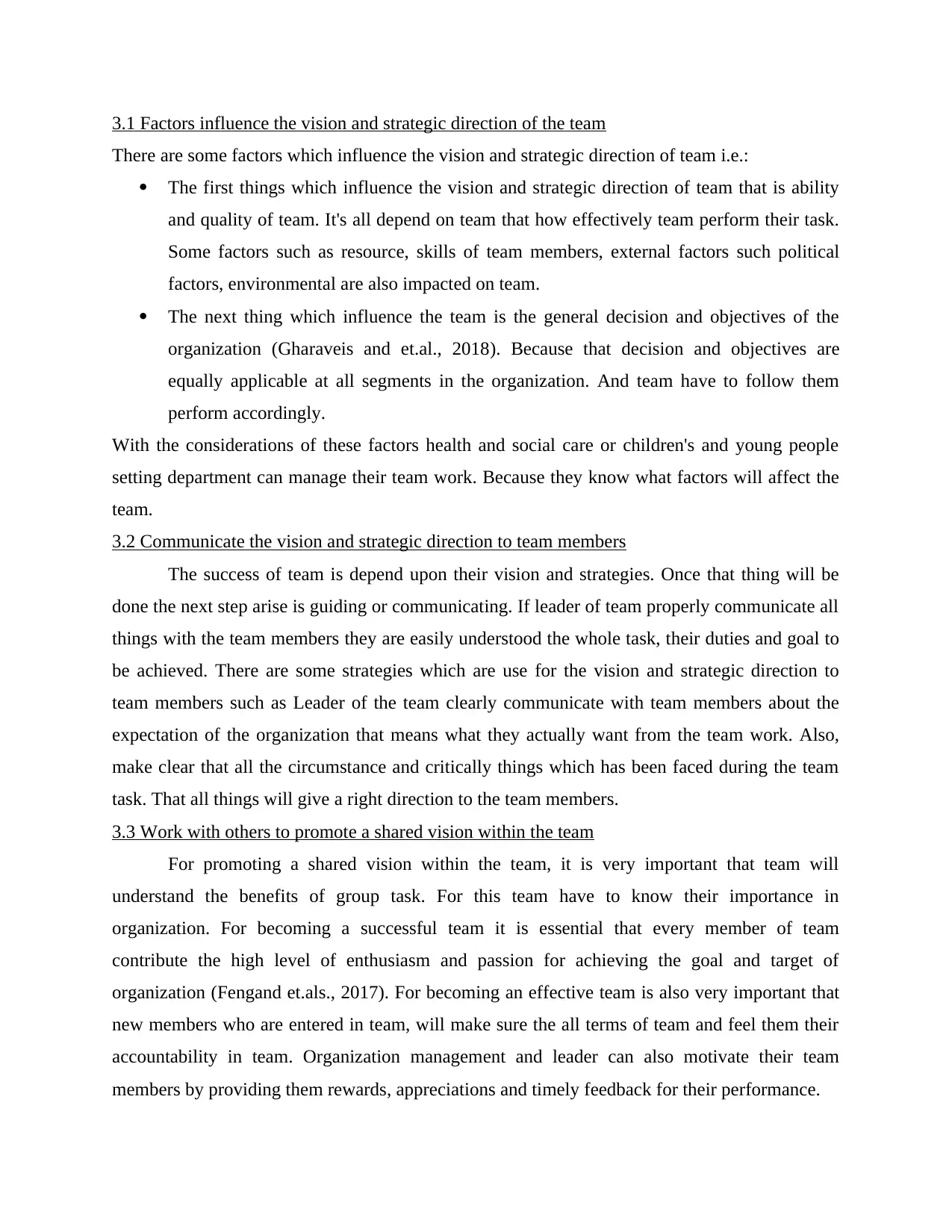
3.1 Factors influence the vision and strategic direction of the team
There are some factors which influence the vision and strategic direction of team i.e.:
The first things which influence the vision and strategic direction of team that is ability
and quality of team. It's all depend on team that how effectively team perform their task.
Some factors such as resource, skills of team members, external factors such political
factors, environmental are also impacted on team.
The next thing which influence the team is the general decision and objectives of the
organization (Gharaveis and et.al., 2018). Because that decision and objectives are
equally applicable at all segments in the organization. And team have to follow them
perform accordingly.
With the considerations of these factors health and social care or children's and young people
setting department can manage their team work. Because they know what factors will affect the
team.
3.2 Communicate the vision and strategic direction to team members
The success of team is depend upon their vision and strategies. Once that thing will be
done the next step arise is guiding or communicating. If leader of team properly communicate all
things with the team members they are easily understood the whole task, their duties and goal to
be achieved. There are some strategies which are use for the vision and strategic direction to
team members such as Leader of the team clearly communicate with team members about the
expectation of the organization that means what they actually want from the team work. Also,
make clear that all the circumstance and critically things which has been faced during the team
task. That all things will give a right direction to the team members.
3.3 Work with others to promote a shared vision within the team
For promoting a shared vision within the team, it is very important that team will
understand the benefits of group task. For this team have to know their importance in
organization. For becoming a successful team it is essential that every member of team
contribute the high level of enthusiasm and passion for achieving the goal and target of
organization (Fengand et.als., 2017). For becoming an effective team is also very important that
new members who are entered in team, will make sure the all terms of team and feel them their
accountability in team. Organization management and leader can also motivate their team
members by providing them rewards, appreciations and timely feedback for their performance.
There are some factors which influence the vision and strategic direction of team i.e.:
The first things which influence the vision and strategic direction of team that is ability
and quality of team. It's all depend on team that how effectively team perform their task.
Some factors such as resource, skills of team members, external factors such political
factors, environmental are also impacted on team.
The next thing which influence the team is the general decision and objectives of the
organization (Gharaveis and et.al., 2018). Because that decision and objectives are
equally applicable at all segments in the organization. And team have to follow them
perform accordingly.
With the considerations of these factors health and social care or children's and young people
setting department can manage their team work. Because they know what factors will affect the
team.
3.2 Communicate the vision and strategic direction to team members
The success of team is depend upon their vision and strategies. Once that thing will be
done the next step arise is guiding or communicating. If leader of team properly communicate all
things with the team members they are easily understood the whole task, their duties and goal to
be achieved. There are some strategies which are use for the vision and strategic direction to
team members such as Leader of the team clearly communicate with team members about the
expectation of the organization that means what they actually want from the team work. Also,
make clear that all the circumstance and critically things which has been faced during the team
task. That all things will give a right direction to the team members.
3.3 Work with others to promote a shared vision within the team
For promoting a shared vision within the team, it is very important that team will
understand the benefits of group task. For this team have to know their importance in
organization. For becoming a successful team it is essential that every member of team
contribute the high level of enthusiasm and passion for achieving the goal and target of
organization (Fengand et.als., 2017). For becoming an effective team is also very important that
new members who are entered in team, will make sure the all terms of team and feel them their
accountability in team. Organization management and leader can also motivate their team
members by providing them rewards, appreciations and timely feedback for their performance.
Paraphrase This Document
Need a fresh take? Get an instant paraphrase of this document with our AI Paraphraser
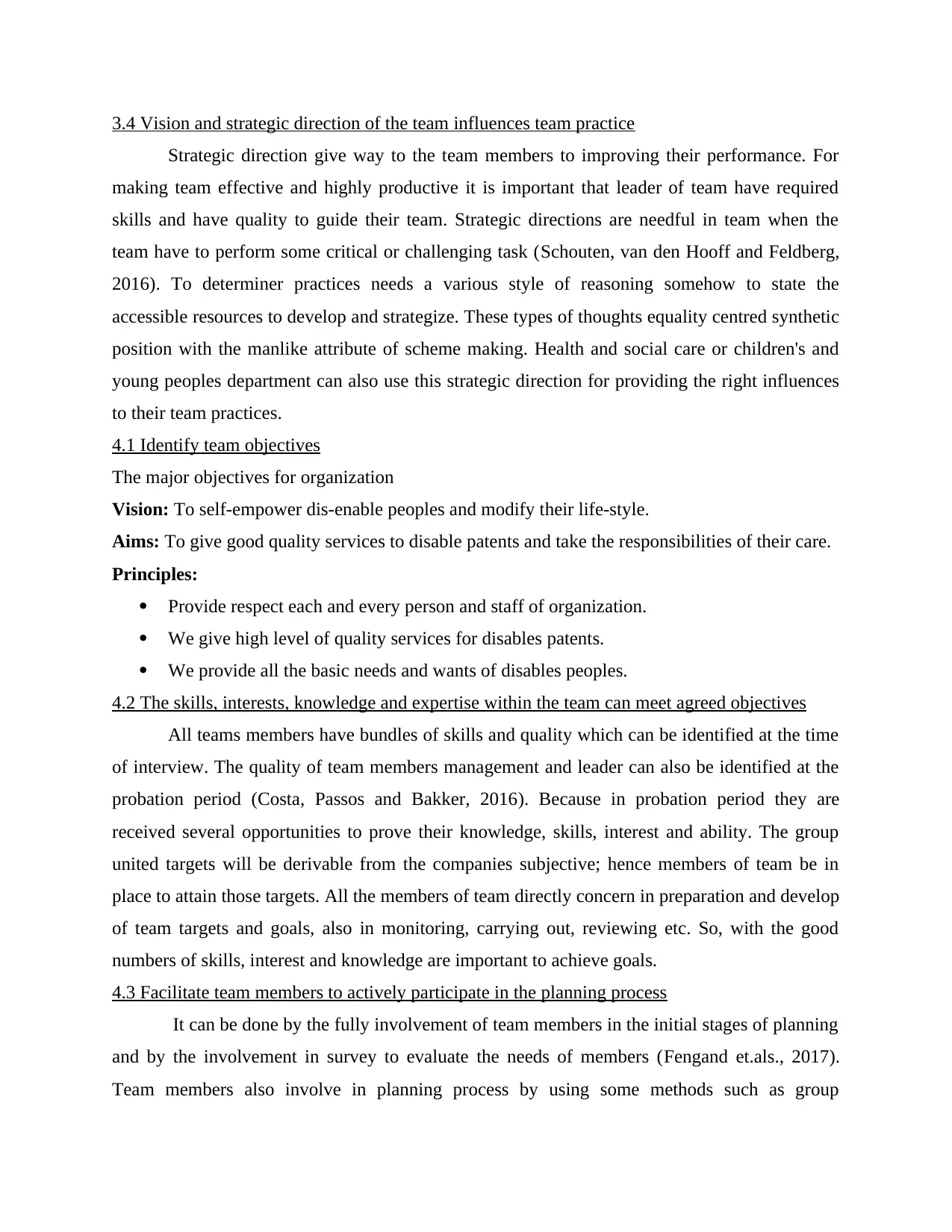
3.4 Vision and strategic direction of the team influences team practice
Strategic direction give way to the team members to improving their performance. For
making team effective and highly productive it is important that leader of team have required
skills and have quality to guide their team. Strategic directions are needful in team when the
team have to perform some critical or challenging task (Schouten, van den Hooff and Feldberg,
2016). To determiner practices needs a various style of reasoning somehow to state the
accessible resources to develop and strategize. These types of thoughts equality centred synthetic
position with the manlike attribute of scheme making. Health and social care or children's and
young peoples department can also use this strategic direction for providing the right influences
to their team practices.
4.1 Identify team objectives
The major objectives for organization
Vision: To self-empower dis-enable peoples and modify their life-style.
Aims: To give good quality services to disable patents and take the responsibilities of their care.
Principles:
Provide respect each and every person and staff of organization.
We give high level of quality services for disables patents.
We provide all the basic needs and wants of disables peoples.
4.2 The skills, interests, knowledge and expertise within the team can meet agreed objectives
All teams members have bundles of skills and quality which can be identified at the time
of interview. The quality of team members management and leader can also be identified at the
probation period (Costa, Passos and Bakker, 2016). Because in probation period they are
received several opportunities to prove their knowledge, skills, interest and ability. The group
united targets will be derivable from the companies subjective; hence members of team be in
place to attain those targets. All the members of team directly concern in preparation and develop
of team targets and goals, also in monitoring, carrying out, reviewing etc. So, with the good
numbers of skills, interest and knowledge are important to achieve goals.
4.3 Facilitate team members to actively participate in the planning process
It can be done by the fully involvement of team members in the initial stages of planning
and by the involvement in survey to evaluate the needs of members (Fengand et.als., 2017).
Team members also involve in planning process by using some methods such as group
Strategic direction give way to the team members to improving their performance. For
making team effective and highly productive it is important that leader of team have required
skills and have quality to guide their team. Strategic directions are needful in team when the
team have to perform some critical or challenging task (Schouten, van den Hooff and Feldberg,
2016). To determiner practices needs a various style of reasoning somehow to state the
accessible resources to develop and strategize. These types of thoughts equality centred synthetic
position with the manlike attribute of scheme making. Health and social care or children's and
young peoples department can also use this strategic direction for providing the right influences
to their team practices.
4.1 Identify team objectives
The major objectives for organization
Vision: To self-empower dis-enable peoples and modify their life-style.
Aims: To give good quality services to disable patents and take the responsibilities of their care.
Principles:
Provide respect each and every person and staff of organization.
We give high level of quality services for disables patents.
We provide all the basic needs and wants of disables peoples.
4.2 The skills, interests, knowledge and expertise within the team can meet agreed objectives
All teams members have bundles of skills and quality which can be identified at the time
of interview. The quality of team members management and leader can also be identified at the
probation period (Costa, Passos and Bakker, 2016). Because in probation period they are
received several opportunities to prove their knowledge, skills, interest and ability. The group
united targets will be derivable from the companies subjective; hence members of team be in
place to attain those targets. All the members of team directly concern in preparation and develop
of team targets and goals, also in monitoring, carrying out, reviewing etc. So, with the good
numbers of skills, interest and knowledge are important to achieve goals.
4.3 Facilitate team members to actively participate in the planning process
It can be done by the fully involvement of team members in the initial stages of planning
and by the involvement in survey to evaluate the needs of members (Fengand et.als., 2017).
Team members also involve in planning process by using some methods such as group
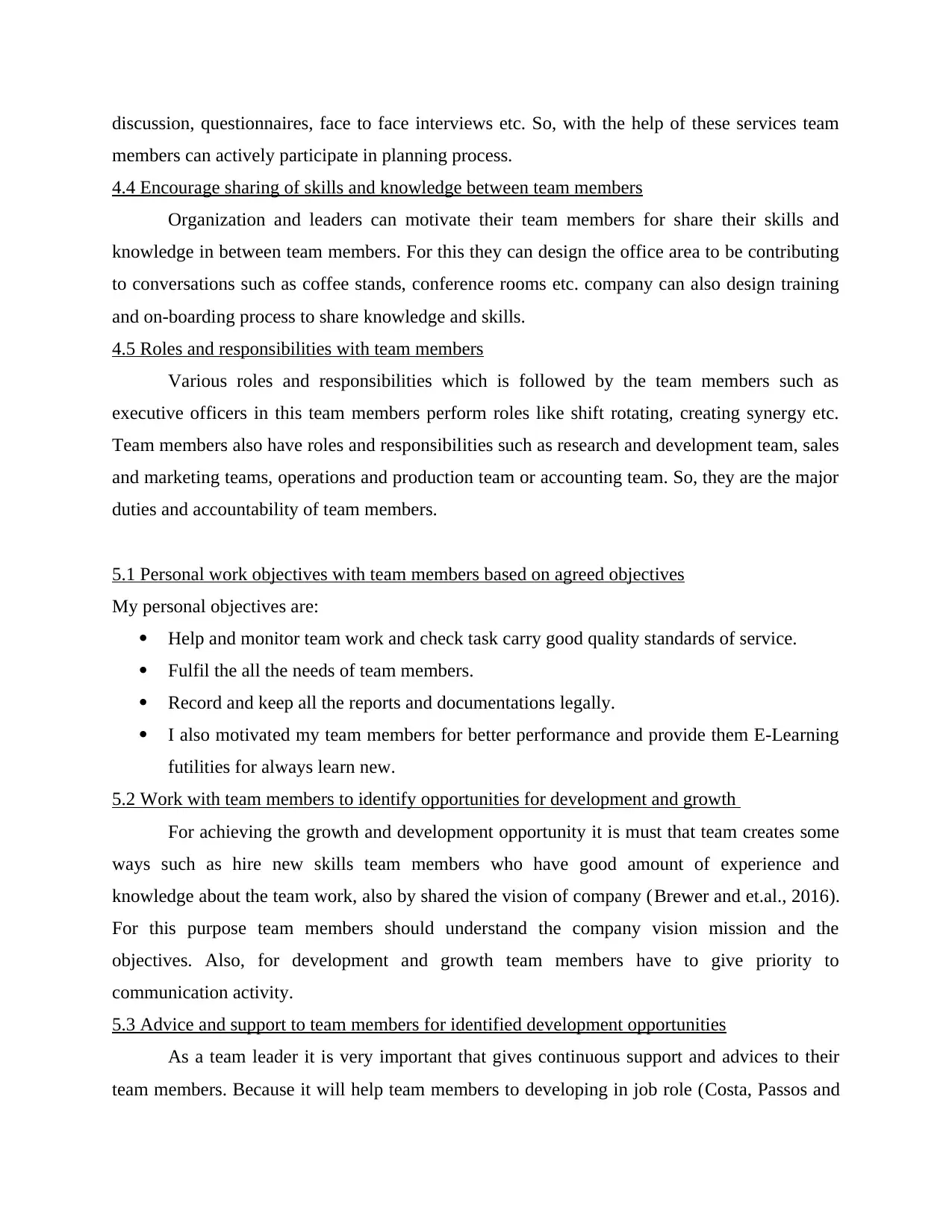
discussion, questionnaires, face to face interviews etc. So, with the help of these services team
members can actively participate in planning process.
4.4 Encourage sharing of skills and knowledge between team members
Organization and leaders can motivate their team members for share their skills and
knowledge in between team members. For this they can design the office area to be contributing
to conversations such as coffee stands, conference rooms etc. company can also design training
and on-boarding process to share knowledge and skills.
4.5 Roles and responsibilities with team members
Various roles and responsibilities which is followed by the team members such as
executive officers in this team members perform roles like shift rotating, creating synergy etc.
Team members also have roles and responsibilities such as research and development team, sales
and marketing teams, operations and production team or accounting team. So, they are the major
duties and accountability of team members.
5.1 Personal work objectives with team members based on agreed objectives
My personal objectives are:
Help and monitor team work and check task carry good quality standards of service.
Fulfil the all the needs of team members.
Record and keep all the reports and documentations legally.
I also motivated my team members for better performance and provide them E-Learning
futilities for always learn new.
5.2 Work with team members to identify opportunities for development and growth
For achieving the growth and development opportunity it is must that team creates some
ways such as hire new skills team members who have good amount of experience and
knowledge about the team work, also by shared the vision of company (Brewer and et.al., 2016).
For this purpose team members should understand the company vision mission and the
objectives. Also, for development and growth team members have to give priority to
communication activity.
5.3 Advice and support to team members for identified development opportunities
As a team leader it is very important that gives continuous support and advices to their
team members. Because it will help team members to developing in job role (Costa, Passos and
members can actively participate in planning process.
4.4 Encourage sharing of skills and knowledge between team members
Organization and leaders can motivate their team members for share their skills and
knowledge in between team members. For this they can design the office area to be contributing
to conversations such as coffee stands, conference rooms etc. company can also design training
and on-boarding process to share knowledge and skills.
4.5 Roles and responsibilities with team members
Various roles and responsibilities which is followed by the team members such as
executive officers in this team members perform roles like shift rotating, creating synergy etc.
Team members also have roles and responsibilities such as research and development team, sales
and marketing teams, operations and production team or accounting team. So, they are the major
duties and accountability of team members.
5.1 Personal work objectives with team members based on agreed objectives
My personal objectives are:
Help and monitor team work and check task carry good quality standards of service.
Fulfil the all the needs of team members.
Record and keep all the reports and documentations legally.
I also motivated my team members for better performance and provide them E-Learning
futilities for always learn new.
5.2 Work with team members to identify opportunities for development and growth
For achieving the growth and development opportunity it is must that team creates some
ways such as hire new skills team members who have good amount of experience and
knowledge about the team work, also by shared the vision of company (Brewer and et.al., 2016).
For this purpose team members should understand the company vision mission and the
objectives. Also, for development and growth team members have to give priority to
communication activity.
5.3 Advice and support to team members for identified development opportunities
As a team leader it is very important that gives continuous support and advices to their
team members. Because it will help team members to developing in job role (Costa, Passos and
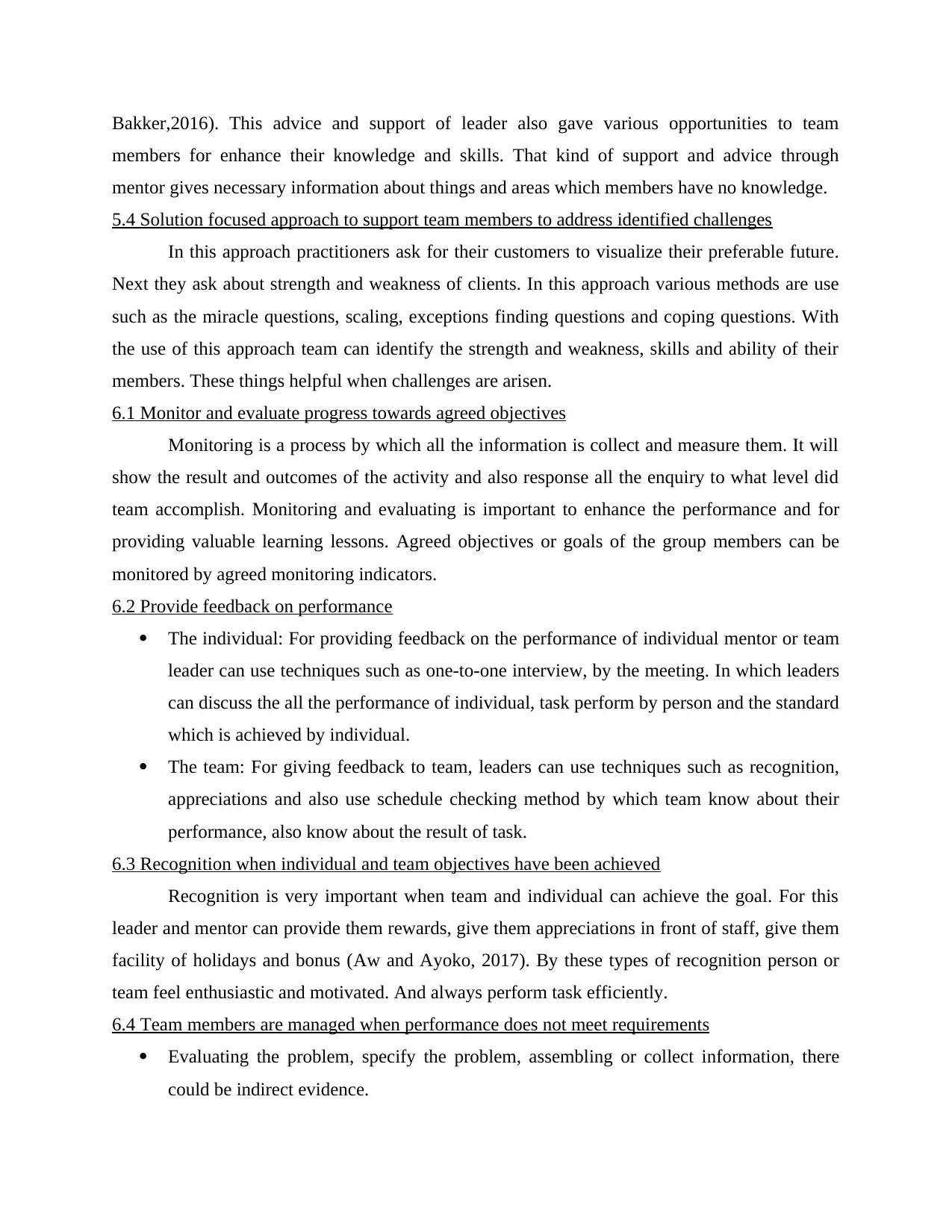
Bakker,2016). This advice and support of leader also gave various opportunities to team
members for enhance their knowledge and skills. That kind of support and advice through
mentor gives necessary information about things and areas which members have no knowledge.
5.4 Solution focused approach to support team members to address identified challenges
In this approach practitioners ask for their customers to visualize their preferable future.
Next they ask about strength and weakness of clients. In this approach various methods are use
such as the miracle questions, scaling, exceptions finding questions and coping questions. With
the use of this approach team can identify the strength and weakness, skills and ability of their
members. These things helpful when challenges are arisen.
6.1 Monitor and evaluate progress towards agreed objectives
Monitoring is a process by which all the information is collect and measure them. It will
show the result and outcomes of the activity and also response all the enquiry to what level did
team accomplish. Monitoring and evaluating is important to enhance the performance and for
providing valuable learning lessons. Agreed objectives or goals of the group members can be
monitored by agreed monitoring indicators.
6.2 Provide feedback on performance
The individual: For providing feedback on the performance of individual mentor or team
leader can use techniques such as one-to-one interview, by the meeting. In which leaders
can discuss the all the performance of individual, task perform by person and the standard
which is achieved by individual.
The team: For giving feedback to team, leaders can use techniques such as recognition,
appreciations and also use schedule checking method by which team know about their
performance, also know about the result of task.
6.3 Recognition when individual and team objectives have been achieved
Recognition is very important when team and individual can achieve the goal. For this
leader and mentor can provide them rewards, give them appreciations in front of staff, give them
facility of holidays and bonus (Aw and Ayoko, 2017). By these types of recognition person or
team feel enthusiastic and motivated. And always perform task efficiently.
6.4 Team members are managed when performance does not meet requirements
Evaluating the problem, specify the problem, assembling or collect information, there
could be indirect evidence.
members for enhance their knowledge and skills. That kind of support and advice through
mentor gives necessary information about things and areas which members have no knowledge.
5.4 Solution focused approach to support team members to address identified challenges
In this approach practitioners ask for their customers to visualize their preferable future.
Next they ask about strength and weakness of clients. In this approach various methods are use
such as the miracle questions, scaling, exceptions finding questions and coping questions. With
the use of this approach team can identify the strength and weakness, skills and ability of their
members. These things helpful when challenges are arisen.
6.1 Monitor and evaluate progress towards agreed objectives
Monitoring is a process by which all the information is collect and measure them. It will
show the result and outcomes of the activity and also response all the enquiry to what level did
team accomplish. Monitoring and evaluating is important to enhance the performance and for
providing valuable learning lessons. Agreed objectives or goals of the group members can be
monitored by agreed monitoring indicators.
6.2 Provide feedback on performance
The individual: For providing feedback on the performance of individual mentor or team
leader can use techniques such as one-to-one interview, by the meeting. In which leaders
can discuss the all the performance of individual, task perform by person and the standard
which is achieved by individual.
The team: For giving feedback to team, leaders can use techniques such as recognition,
appreciations and also use schedule checking method by which team know about their
performance, also know about the result of task.
6.3 Recognition when individual and team objectives have been achieved
Recognition is very important when team and individual can achieve the goal. For this
leader and mentor can provide them rewards, give them appreciations in front of staff, give them
facility of holidays and bonus (Aw and Ayoko, 2017). By these types of recognition person or
team feel enthusiastic and motivated. And always perform task efficiently.
6.4 Team members are managed when performance does not meet requirements
Evaluating the problem, specify the problem, assembling or collect information, there
could be indirect evidence.
Secure Best Marks with AI Grader
Need help grading? Try our AI Grader for instant feedback on your assignments.
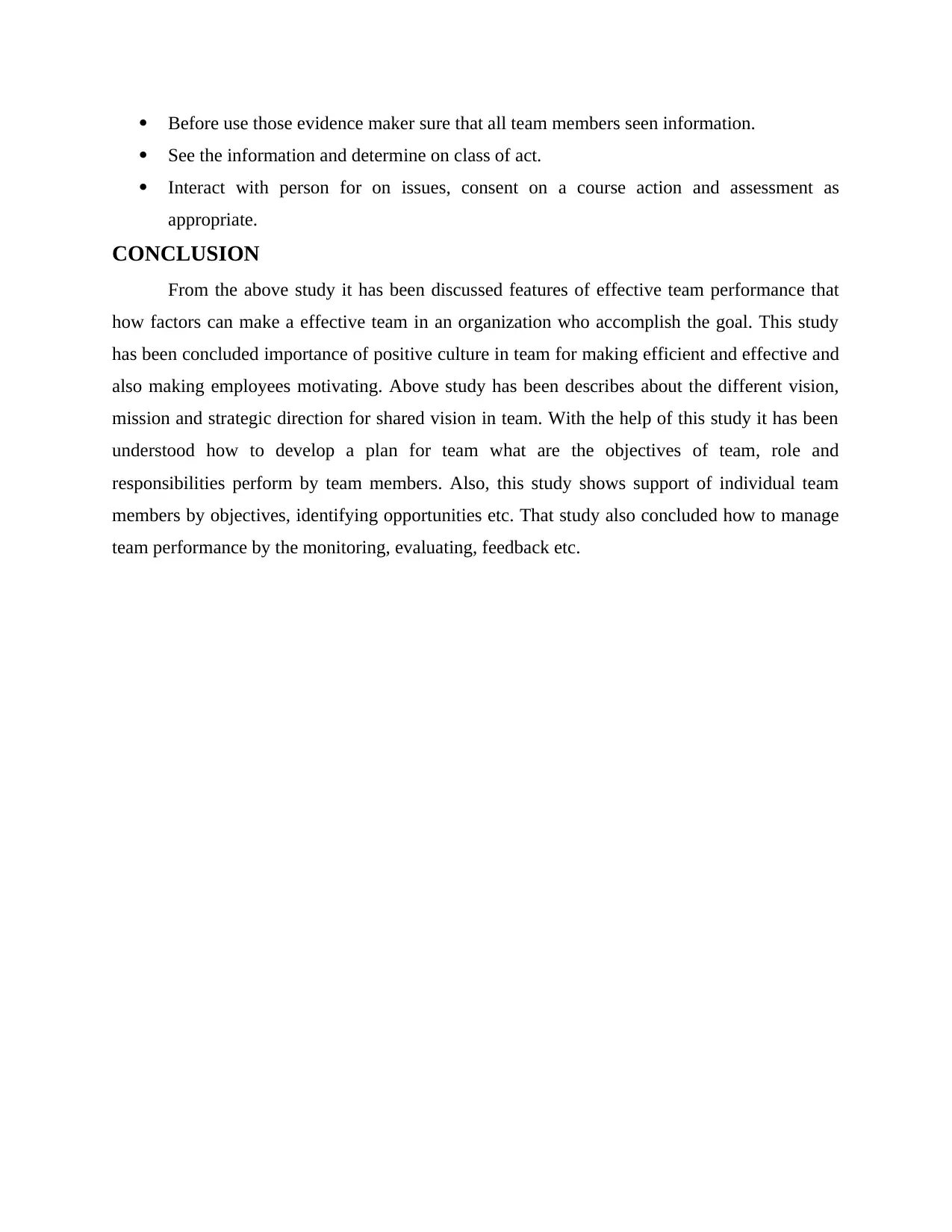
Before use those evidence maker sure that all team members seen information.
See the information and determine on class of act.
Interact with person for on issues, consent on a course action and assessment as
appropriate.
CONCLUSION
From the above study it has been discussed features of effective team performance that
how factors can make a effective team in an organization who accomplish the goal. This study
has been concluded importance of positive culture in team for making efficient and effective and
also making employees motivating. Above study has been describes about the different vision,
mission and strategic direction for shared vision in team. With the help of this study it has been
understood how to develop a plan for team what are the objectives of team, role and
responsibilities perform by team members. Also, this study shows support of individual team
members by objectives, identifying opportunities etc. That study also concluded how to manage
team performance by the monitoring, evaluating, feedback etc.
See the information and determine on class of act.
Interact with person for on issues, consent on a course action and assessment as
appropriate.
CONCLUSION
From the above study it has been discussed features of effective team performance that
how factors can make a effective team in an organization who accomplish the goal. This study
has been concluded importance of positive culture in team for making efficient and effective and
also making employees motivating. Above study has been describes about the different vision,
mission and strategic direction for shared vision in team. With the help of this study it has been
understood how to develop a plan for team what are the objectives of team, role and
responsibilities perform by team members. Also, this study shows support of individual team
members by objectives, identifying opportunities etc. That study also concluded how to manage
team performance by the monitoring, evaluating, feedback etc.
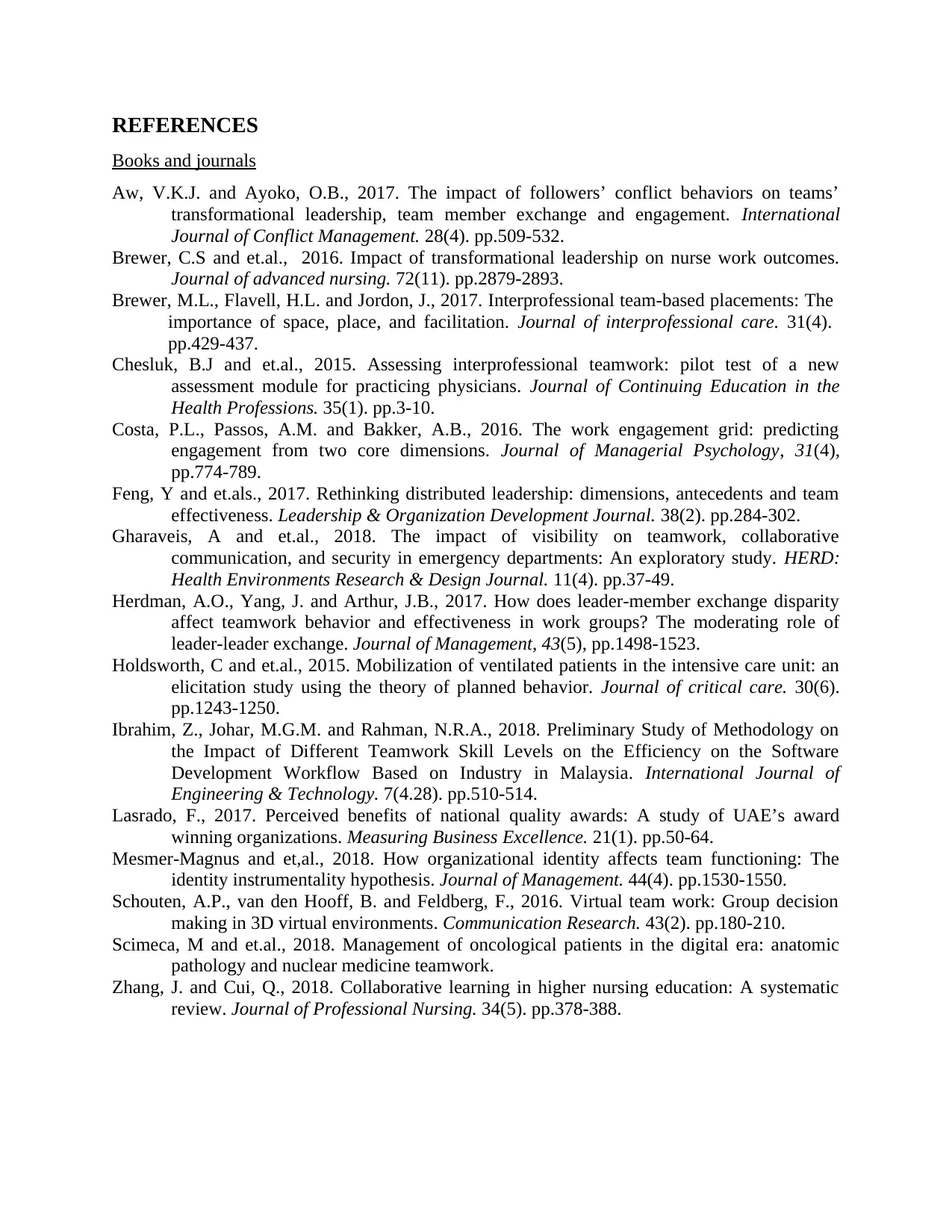
REFERENCES
Books and journals
Aw, V.K.J. and Ayoko, O.B., 2017. The impact of followers’ conflict behaviors on teams’
transformational leadership, team member exchange and engagement. International
Journal of Conflict Management. 28(4). pp.509-532.
Brewer, C.S and et.al., 2016. Impact of transformational leadership on nurse work outcomes.
Journal of advanced nursing. 72(11). pp.2879-2893.
Brewer, M.L., Flavell, H.L. and Jordon, J., 2017. Interprofessional team-based placements: The
importance of space, place, and facilitation. Journal of interprofessional care. 31(4).
pp.429-437.
Chesluk, B.J and et.al., 2015. Assessing interprofessional teamwork: pilot test of a new
assessment module for practicing physicians. Journal of Continuing Education in the
Health Professions. 35(1). pp.3-10.
Costa, P.L., Passos, A.M. and Bakker, A.B., 2016. The work engagement grid: predicting
engagement from two core dimensions. Journal of Managerial Psychology, 31(4),
pp.774-789.
Feng, Y and et.als., 2017. Rethinking distributed leadership: dimensions, antecedents and team
effectiveness. Leadership & Organization Development Journal. 38(2). pp.284-302.
Gharaveis, A and et.al., 2018. The impact of visibility on teamwork, collaborative
communication, and security in emergency departments: An exploratory study. HERD:
Health Environments Research & Design Journal. 11(4). pp.37-49.
Herdman, A.O., Yang, J. and Arthur, J.B., 2017. How does leader-member exchange disparity
affect teamwork behavior and effectiveness in work groups? The moderating role of
leader-leader exchange. Journal of Management, 43(5), pp.1498-1523.
Holdsworth, C and et.al., 2015. Mobilization of ventilated patients in the intensive care unit: an
elicitation study using the theory of planned behavior. Journal of critical care. 30(6).
pp.1243-1250.
Ibrahim, Z., Johar, M.G.M. and Rahman, N.R.A., 2018. Preliminary Study of Methodology on
the Impact of Different Teamwork Skill Levels on the Efficiency on the Software
Development Workflow Based on Industry in Malaysia. International Journal of
Engineering & Technology. 7(4.28). pp.510-514.
Lasrado, F., 2017. Perceived benefits of national quality awards: A study of UAE’s award
winning organizations. Measuring Business Excellence. 21(1). pp.50-64.
Mesmer-Magnus and et,al., 2018. How organizational identity affects team functioning: The
identity instrumentality hypothesis. Journal of Management. 44(4). pp.1530-1550.
Schouten, A.P., van den Hooff, B. and Feldberg, F., 2016. Virtual team work: Group decision
making in 3D virtual environments. Communication Research. 43(2). pp.180-210.
Scimeca, M and et.al., 2018. Management of oncological patients in the digital era: anatomic
pathology and nuclear medicine teamwork.
Zhang, J. and Cui, Q., 2018. Collaborative learning in higher nursing education: A systematic
review. Journal of Professional Nursing. 34(5). pp.378-388.
Books and journals
Aw, V.K.J. and Ayoko, O.B., 2017. The impact of followers’ conflict behaviors on teams’
transformational leadership, team member exchange and engagement. International
Journal of Conflict Management. 28(4). pp.509-532.
Brewer, C.S and et.al., 2016. Impact of transformational leadership on nurse work outcomes.
Journal of advanced nursing. 72(11). pp.2879-2893.
Brewer, M.L., Flavell, H.L. and Jordon, J., 2017. Interprofessional team-based placements: The
importance of space, place, and facilitation. Journal of interprofessional care. 31(4).
pp.429-437.
Chesluk, B.J and et.al., 2015. Assessing interprofessional teamwork: pilot test of a new
assessment module for practicing physicians. Journal of Continuing Education in the
Health Professions. 35(1). pp.3-10.
Costa, P.L., Passos, A.M. and Bakker, A.B., 2016. The work engagement grid: predicting
engagement from two core dimensions. Journal of Managerial Psychology, 31(4),
pp.774-789.
Feng, Y and et.als., 2017. Rethinking distributed leadership: dimensions, antecedents and team
effectiveness. Leadership & Organization Development Journal. 38(2). pp.284-302.
Gharaveis, A and et.al., 2018. The impact of visibility on teamwork, collaborative
communication, and security in emergency departments: An exploratory study. HERD:
Health Environments Research & Design Journal. 11(4). pp.37-49.
Herdman, A.O., Yang, J. and Arthur, J.B., 2017. How does leader-member exchange disparity
affect teamwork behavior and effectiveness in work groups? The moderating role of
leader-leader exchange. Journal of Management, 43(5), pp.1498-1523.
Holdsworth, C and et.al., 2015. Mobilization of ventilated patients in the intensive care unit: an
elicitation study using the theory of planned behavior. Journal of critical care. 30(6).
pp.1243-1250.
Ibrahim, Z., Johar, M.G.M. and Rahman, N.R.A., 2018. Preliminary Study of Methodology on
the Impact of Different Teamwork Skill Levels on the Efficiency on the Software
Development Workflow Based on Industry in Malaysia. International Journal of
Engineering & Technology. 7(4.28). pp.510-514.
Lasrado, F., 2017. Perceived benefits of national quality awards: A study of UAE’s award
winning organizations. Measuring Business Excellence. 21(1). pp.50-64.
Mesmer-Magnus and et,al., 2018. How organizational identity affects team functioning: The
identity instrumentality hypothesis. Journal of Management. 44(4). pp.1530-1550.
Schouten, A.P., van den Hooff, B. and Feldberg, F., 2016. Virtual team work: Group decision
making in 3D virtual environments. Communication Research. 43(2). pp.180-210.
Scimeca, M and et.al., 2018. Management of oncological patients in the digital era: anatomic
pathology and nuclear medicine teamwork.
Zhang, J. and Cui, Q., 2018. Collaborative learning in higher nursing education: A systematic
review. Journal of Professional Nursing. 34(5). pp.378-388.

Paraphrase This Document
Need a fresh take? Get an instant paraphrase of this document with our AI Paraphraser



1 out of 16
Related Documents
Your All-in-One AI-Powered Toolkit for Academic Success.
+13062052269
info@desklib.com
Available 24*7 on WhatsApp / Email
![[object Object]](/_next/static/media/star-bottom.7253800d.svg)
Unlock your academic potential
© 2024 | Zucol Services PVT LTD | All rights reserved.





